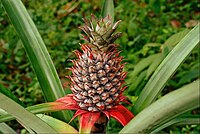
Photo from wikipedia
Pineapple is a crassulacean acid metabolism (CAM) plant with high economic value. Originated at semi-arid regions where water is limited, CAM plant is known for its high water use efficiency… Click to show full abstract
Pineapple is a crassulacean acid metabolism (CAM) plant with high economic value. Originated at semi-arid regions where water is limited, CAM plant is known for its high water use efficiency (WUE). Aquaporin regulates whole plant level water usage and transportation, which are critical for many physiological processes, including photosynthesis. Systematically identification and analyses of the aquaporin family resulted in detailed annotation of this gene family in pineapple. Among the 36 aquaporins identified in pineapple genome, 10 members were found in the TIP subfamily, 10 members were found in the PIP subfamily, 11 members were found in the NIP subfamily, and 3 members were found in the SIP subfamily. Additionally, there was also one TIP1-like aquaporin and one NIP1-like aquaporin that shared sequence similarity to TIP1 and NIP1 aquaporins respectively. Using transcriptome data from leaf tissues sampled every 2 hs in 24 h, we discovered aquaporin genes with circadian expression patterns in the domesticated pineapple and revealed the potential functions of all aquaporin genes for pineapple and CAM plants in general. To understand the domestication history of aquaporin, we compared the aquaporins from wild pineapple and cultivars, and found that the aquaporin expression profile in domesticated pineapple fruit development is very different from the wild pineapple, implicating the importance of aquaporin genes in the process of domesticated fruit development, such as rapid fruit expansion and ripening. This research has also targeted aquaporin subfamily nodulin26-like intrinsic protein5-1 (NIP5-1) gene in pineapple, which plays an important role in boron transportation, and had not yet been revealed in any monocot species. CAM plant has unique circadian regulation mechanisms for aquaporin genes in comparison with C3 plants, which might be critical for its effective plant water utilization. Our result provided new insights into evolution and functional diversification of the CAM aquaporin family, and yielded genomic resources for improving WUE and boron transportation in C3 and cereal crops.
Journal Title: Euphytica
Year Published: 2019
Link to full text (if available)
Share on Social Media: Sign Up to like & get
recommendations!